 [Image Source: https://brilliantperspectives.com/crafting-a-prayer/%5D
[Image Source: https://brilliantperspectives.com/crafting-a-prayer/%5DAaj Ibaadat
 [Image Source: https://brilliantperspectives.com/crafting-a-prayer/%5D
[Image Source: https://brilliantperspectives.com/crafting-a-prayer/%5D [Image Source: https://brilliantperspectives.com/crafting-a-prayer/%5D
[Image Source: https://brilliantperspectives.com/crafting-a-prayer/%5DIt is the season of mist and it is the zodiac of Capricorn, so go listen to Mist of Capricorn right now! To be clear, you should listen to this in other seasons and zodiacs as well, because that’s how awesome this piece is 😀
A crude summary is that this piece is a a traditional Carnatic classical composition with a contemporary arrangement, but what makes the piece so heartwarming is the soul put into it. This piece is by the band Agam which may I proudly say is a BITSian band (most of the band members are BITS Pilani alumni).
 The base composition is a traditional Carnatic kriti by Thyagaraja (one of the trinity composers of the Carnatic world). This is based in Raag Nalinikanti which is vaguely similar to Raag Tilak Kamod in the Hindustani world. The lyrics are contemplative; Thyagaraja is appealing to his mind to listen to his secrets.
The base composition is a traditional Carnatic kriti by Thyagaraja (one of the trinity composers of the Carnatic world). This is based in Raag Nalinikanti which is vaguely similar to Raag Tilak Kamod in the Hindustani world. The lyrics are contemplative; Thyagaraja is appealing to his mind to listen to his secrets.
The original melody is already immensely charming, and Agam has done an amazing job of embellishing it with soft contemporary instrumentation. I especially love the guitar solos and the use of chorus in parts. The whole piece is an absolute treat to the ears, but if I were to pick an interval, then 4:10 – 4:35 just melts my heart 🙂
Over time, Coke Studio Pakistan has established itself as a source of some brilliant music. It has really got it right in terms of the concept and its implementation and of course the soul. Their seventh season kicked off a few months back and they have some really good pieces this time. The piece that especially stands out for me is Main Sufi Hoon by Abida Parveen and Ustad Rais Khan. This is a Sufi composition based in Raag Baageshri.
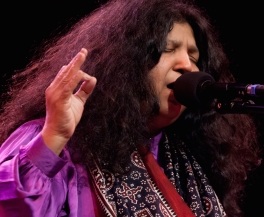 The Artists: Abida Parveen, a pioneer Sufi musician is definitely among the best artists alive today and one of my personal favorites. There is a mystical aura around her that is intriguing yet inviting. The purity of her soul and her musical penance reflects in her clairvoyant voice. Her vocals have an exquisite husk and vibrato which is not to be mistaken as an inherent characteristic. Such a voice can only be attained after years of Riyaaz. I often hear people complementing singers about what an amazing voice they have; I feel that’s a really bad way to compliment a good singer ! Such a compliment almost implies that a singer’s voice is a result of some genetic lottery. It is important to appreciate the effort that goes into a mesmerizing voice, into a structured performance and not just attribute it to some act of fate.
The Artists: Abida Parveen, a pioneer Sufi musician is definitely among the best artists alive today and one of my personal favorites. There is a mystical aura around her that is intriguing yet inviting. The purity of her soul and her musical penance reflects in her clairvoyant voice. Her vocals have an exquisite husk and vibrato which is not to be mistaken as an inherent characteristic. Such a voice can only be attained after years of Riyaaz. I often hear people complementing singers about what an amazing voice they have; I feel that’s a really bad way to compliment a good singer ! Such a compliment almost implies that a singer’s voice is a result of some genetic lottery. It is important to appreciate the effort that goes into a mesmerizing voice, into a structured performance and not just attribute it to some act of fate.
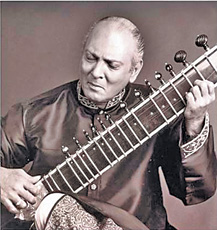 Ustad Rais Khan comes from a rich Sitar tradition, he is the nephew of the revered Ustad Vilayat Khan. He is an imminent classical instrumentalist and was a pioneer of the Mewati Gharana of the town of Indore in central India. He developed his own unique style of performance integrating elements from Hindustani classical vocals and existing Sitar techniques and also incorporating exquisite meend in his alaapi (improvisation of the Raag). Here is a beautiful rendition of Raag Yaman Kalyan.
Ustad Rais Khan comes from a rich Sitar tradition, he is the nephew of the revered Ustad Vilayat Khan. He is an imminent classical instrumentalist and was a pioneer of the Mewati Gharana of the town of Indore in central India. He developed his own unique style of performance integrating elements from Hindustani classical vocals and existing Sitar techniques and also incorporating exquisite meend in his alaapi (improvisation of the Raag). Here is a beautiful rendition of Raag Yaman Kalyan.
It is interesting to see how differently both Abida and Ustad approach the stage. For Abida, the performance is an internal meditative process. Her eyes are mostly closed. For the first few times she makes an effort to put back her headphones as they slip from her head, but eventually she gets so engrossed in the musical atmosphere that she forgets about them completely. In contrast, you see Raees Khan being outward in his performance. He communicates with other musicians and gets immersed in the musical atmosphere through this interaction. The final destination for any artist is the same: eternal bliss; But each has their own way of getting there !
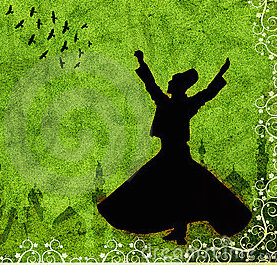 Lyrics: Sufism talks about realizing the ultimate truth and being one with the highest power. The practice of Sufism, also called Tarigat is a path of love and devotion, a practice which endorses peace. It involves enlightenment of the inner being, not by logic or intellectual proof but by self experience and revelation. To me, Sufi philosophy seems very close to the Hindu or Yoga philosophy of Adwaita where again, the ultimate goal is to be one with divinity through self realization.
Lyrics: Sufism talks about realizing the ultimate truth and being one with the highest power. The practice of Sufism, also called Tarigat is a path of love and devotion, a practice which endorses peace. It involves enlightenment of the inner being, not by logic or intellectual proof but by self experience and revelation. To me, Sufi philosophy seems very close to the Hindu or Yoga philosophy of Adwaita where again, the ultimate goal is to be one with divinity through self realization.
This particular Sufi composition is by Saint Kabir. Kabir is an interesting philosopher/poet, associated with Hindu, Islamic, Sikh and Sufi ideologies alike. Hence you find a unique mix of words like ‘Maula’, ’Quraan’, ‘Mullaah’, ‘Pandit’, ’Hari’ in this poetry. A particularly powerful Doha (a set of two lines) in this composition is:
In essence, it says that as long as your ego is hovering over you, you cannot hope to be one with God. Till then, we are in a state of ignorance, state of internal darkness and light can usher in only when we are able to transcend beyond our ego. In spirit, it reiterates the Adwaita philosophy mentioned before.
Instrumentation: With a Sitar maestro on the stage, there isn’t much instrumental effect you need. They have done exactly that and have kept the rhythm and overall effect mellow. There is minimal use of drums and a pleasant Dadra (a six beat rhythm cycle) on the Tabla. They are using a soft six-beat rift on the guitar. The Sitar of course, takes care of all the interludes ! Towards the end, lot of instruments merge in, there is a greater drumming effect and all of it leads to a wonderful climax.
For the more interested listener:
This piece is set in Raag Bageshree, a predominant Raag in Hindustani classical music. This Raag is performed at night time and has a sort of pensive melancholic mood. It has a komal (Flat) gandhaar and komal nishaad with a meend, which effectively create the intended mood. A nice introduction to the Raag is this Drut by Sanjeev Abhyankar. Another beautiful rendition on the Sitar is by the evergreen Ustad Shahid Parvez.
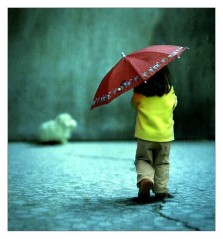 Monsoons in India are almost over and chilling winds have set in to pave the way for winter. The rains kept our company for almost four months, sometimes as a pleasant companion, sometimes as a long lost friend who came to surprise us and sometimes even that annoying person who just wouldn’t let us be in peace !! But I think we all agree that the beginning of monsoons is a truly delightful period. The schools in India start around the same time. When I see kids walking towards schools in their rainy shoes and cute umbrellas, I am always reminded of this beautiful song from the movie The Blue Umbrella: Chatri ka Udan Khatola
Monsoons in India are almost over and chilling winds have set in to pave the way for winter. The rains kept our company for almost four months, sometimes as a pleasant companion, sometimes as a long lost friend who came to surprise us and sometimes even that annoying person who just wouldn’t let us be in peace !! But I think we all agree that the beginning of monsoons is a truly delightful period. The schools in India start around the same time. When I see kids walking towards schools in their rainy shoes and cute umbrellas, I am always reminded of this beautiful song from the movie The Blue Umbrella: Chatri ka Udan Khatola
This movie is based on a short story by Ruskin Bond by the same name. Ruskin Bond has a knack of capturing the subtle emotions of kids and of course weaving it beautifully into words. Vishal bharadwaj has done complete justice to the short story while making this movie. The movie has also won the National Film Award in the year 2007 and I will recommend this sweet movie to everyone. The story is based in a remote village of Himachal Pradesh where a small girl gets hold of a wonderful blue umbrella. The story is extremely simple and perfectly captures the innocence of children.
The feel of the song: The girl has just got a brand new umbrella, plus she is from a remote village where possessing such an umbrella itself is a remote idea. Of course the girl is highly excited about the umbrella and takes it everywhere she goes. Just recollect the excitement of any kid when he/she sets eyes on a new toy, that is exactly the emotion this song is trying to capture. The song describes the amazing things that the umbrella does from the perspective of a child.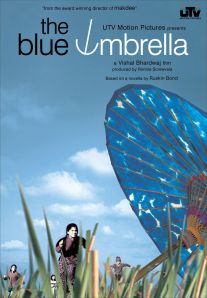
The rhythm: The song makes use of bouncy rhythms throughout the song, keeping in tune with the intended enthusiasm of the song. The percussion elements from the region of Himachal like the manjira or jhanjh have also been used occassionally for a garnishing effect.
Vocals: The vocalist Upagna Pandya has done a nice job in rendering the lyrics of the song with an endearing childlike enthusiasm. The throw of her voice in the higher parts is quite precise, especially considering her age. The chorus is an excellent means of adding to the childlike feel. Harmonies have also been used nicely in the chorus.
Interplay of major and minor scales: The synthesizer has been used extensively to create crescendos. Since this is a kids song, it has fast transitions of moods to reflect the bubbly and transient nature of kids. These transitions are achieved by changing extensively between minor and major chords, especially in the chorus. Along with the chord transitions, the mood change is achieved by modulating rhythm as well. There is a nice mix of fast paced sections going towards a climax and slow emotional parts.
For the more interested listener: This song uses elements from the folk music of Himachal Pradesh. The state is amidst the Himalayas, one of the most scenic parts of the world and subsequently the music also reflects the freshness of this region. They have a wide range of percussion instruments and wind instruments. In fact I feel that the wind instruments like flute aptly bring out the windy feel of the mountains. Here is a nice Himachal folk song by Mohit Chauhan.
The melodies of this region are typically called Pahadi Dhuns. Many Hindustani classical instrumentalists play these Dhuns as a part of their performances. This is a soulful rendering of a Pahadi Dhun by Pandit Shivkumar Sharma.
Since the time I have heard My Immortal for the first time, which was almost 5 years ago, I have been in love with it. It spurs in me an unsaid, unsung emotion. There have been numerous songs about death and the pain of separation, but somehow this song takes the sentiment to a new level. I believe that the greatness of any musical composition lies in how well it can communicate an emotion, how deeply it can touch your soul with it. If a song can give you the flavor of any emotion, without having to actually experience that particular situation, then the song has definitely achieved something. Thus, I believe that music has been responsible in making the society more empathetic for ages!
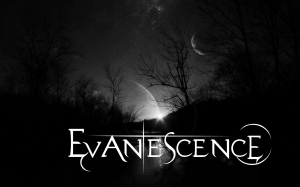 My Immortal is a popular song by the band Evanescence and sung by Amy Lee. Evanescence is a rock band that combines the genres of Gothic rock and Pop. It grabbed the limelight with its debut album ‘Fallen’ and even bagged two Grammy awards for the same. All of their songs have a tinge of darkness or a philosophical melancholy to it. This song is from the debut album of the band and addresses death in an unconventional way. The video of the song, made in black and white has also been highly acclaimed.
My Immortal is a popular song by the band Evanescence and sung by Amy Lee. Evanescence is a rock band that combines the genres of Gothic rock and Pop. It grabbed the limelight with its debut album ‘Fallen’ and even bagged two Grammy awards for the same. All of their songs have a tinge of darkness or a philosophical melancholy to it. This song is from the debut album of the band and addresses death in an unconventional way. The video of the song, made in black and white has also been highly acclaimed.
Lyrics: The loss of a dear one is probably among the hardest things that we have to deal with in life. Quite often, we tend to trap ourselves in the memories of our beloved and mentally refuse to move on. And just when we accomplish the impossible, just when we prepare yourself to move on we realize that there is too much of that person left in us to let us move on..
” I’ve tried so hard to tell myself that you’re gone
But though you’re still with me
I’ve been alone all along “
This song exactly captures this. Its when the spirit of the departed is always with you, whatever you do reminds you of them, the spirit literally haunts you. And ultimately that memory becomes a bit too much to handle, a bit too much to be able to escape into normalcy.
Instrumentation: This song is considered to be a power ballad in the gothic rock genre. The piano is absolutely brilliant in the song and is the soul of the song, I feel. The chords successfully create a dark and melancholic mood.  Amy Lee has also done a wonderful job with the vocals. Also, she has been able to add a personal touch to the song since she had to experience the grief of separation from her sister when she was young. Apart from that, lot of layering and harmonic effects embellish the overall vocals.
Amy Lee has also done a wonderful job with the vocals. Also, she has been able to add a personal touch to the song since she had to experience the grief of separation from her sister when she was young. Apart from that, lot of layering and harmonic effects embellish the overall vocals.
A typical characteristic of the rock genre is that the drums and electric guitars kick in at the end, sometimes even with amazing solos. This characteristic can be observed even in this song. Such instrumentation creates an effect of a crescendo or a climax for the song.
The Morse Code Mystery: In some of the versions of the song like this, or especially the version in the album Fallen, you can hear a beeps code at the end. This is created by holding notes of the piano for a longer duration. People believed it to be Morse code of some kind.
But the guitarist of the song Ben Moody clarified that it was actually a preset pattern on a keyboard synthesizer that they were using on the song. In this pattern, by sustaining the note long enough, it trails off into this beeping that sounds a lot like Morse Code. The band just thought that it sounded really cool, so they left it. So it’s there by accident. But maybe it would be quite cool to confirm this and check if the code actually decodes to something!!
For the more interested listener…
A ballad has its origins in the forms of poetry of the medieval era. It’s a poem that tells a story, a poem characterized by the narrative pattern of its verses. Power ballads came up in the 1970s when rock music felt the need to go beyond mere creative pursuits and try to convey profound messages to the audiences. Power ballads are broadly categorized into Fistpumpers and Tearjerkers.
The Fistpumpers typically hint of a masculine touch, they are about men who aren’t afraid to talk their heart out, stand up for something they truly believe in. Such ballads may even take recourse to preposterous lyrics. Stairway to Heaven by Led Zeppelin was among the pioneering power ballads. Even November Rain by Guns n Roses is an apt example of a Fistpumper.
The Tearjerkers are about emotion. They talk about love, and more often about loss of it. They will build a truly melancholic atmosphere before reaching the heart tearing climax. The most famous Tearjerkers are usually in female voices. Apart from My Immortal, Celine Dion’s Think Twice is also a powerful Tearjerker.
Gothic rock emerged from the genre of Punk rock as an attempt to reduce the funky and random nature of rock and lead it towards some discipline. Gothic rock deals with introspective dark themes and the poetic sensibilities of the genre led the lyrics to exhibit literary morbidity, religious symbolism and supernatural mysticism. This is one of the songs by the band Bauhaus, a band considered to be the revolutionary gothic rock band.
PS: In the video, Amy Lee represents the departed spirit and her feet are shown to never touch the ground.
Welcome to Rajasthan, the land of the Rajputs and the land of their exquisite palaces: ‘Padharo mhare des’.
If you visit Rajasthan, you will probably hear the song Kesariya Balam at every tourist destination. This is the traditional folk song of Rajasthan, it’s about a wife welcoming her husband, her lover, her Balam home, after a long time. In the ancient Rajput times, the kings used to go away on wars and would get a royal welcome on coming back with songs like these.
Somehow this folk song has not yet lost its cult status in spite of its ubiquitous nature. The version of the song mentioned above is from the movie Dor. Salim-Suleiman have done a marvelous job in recreating the traditional folk while infusing some modern instruments in it.
Instrumentation:
 Rajasthani music always comes with abundant Sarangi. Sarangi is an instrument which is considered closest to the human voice. Interestingly many of the compositions in Rajasthani folk are based in Raag Sarang. However this song is based in Raag Maand. Maand and Sarang are afternoon raags and I feel they bring out the harsh sunny mood and sparsely vegetated terrain of Rajasthan, listening to them will somehow give you the feeling of travelling on a severe afternoon or being in a desert. They also give a feeling of longing, of craving just like the Rajasthani terrain longs for a shower of rain.
Rajasthani music always comes with abundant Sarangi. Sarangi is an instrument which is considered closest to the human voice. Interestingly many of the compositions in Rajasthani folk are based in Raag Sarang. However this song is based in Raag Maand. Maand and Sarang are afternoon raags and I feel they bring out the harsh sunny mood and sparsely vegetated terrain of Rajasthan, listening to them will somehow give you the feeling of travelling on a severe afternoon or being in a desert. They also give a feeling of longing, of craving just like the Rajasthani terrain longs for a shower of rain.
For the rhythm, a kind of Dholak is used with a six beat cycle. The rhythm is not just a simple six beat pattern, but a bit complex one, influenced from the style of walking of the camel! The piece also has nice flute elements to keep in tune with the theme of the movie.
Vocals:
A natural husk and vibrato in voice are characteristic to Rajasthani folk. Plus, the voices are distinctively high-pitched. In this piece as well, the singers vibrating voices bring out a nice effect. The folk is usually sung in a group and here also some parts are sung in chorus, keeping with the tradition.
Other versions:
There are of course thousands of versions of this folk song. Usually, for any folk song, the flavor of rendition changes slightly as you move into different sub regions, moreover Kesariya Balam to Rajasthani folk is just like Sachin is to Indian cricket, can’t really say which one of them defines the other ! So this is a version of how the song is still sung at the forts, for the tourists.
This song was originally popularized by Lata Mangeshkar in the film Lekin. The song is definitely commendable for the vocals and the lyrics, but I feel that somehow, it has lost the folk touch. Same is the case with this rendition by Mehdi Hassan. He sings the song in a 7 beat cycle rather than the traditional 6 beat Dadra cycle. Richa Sharma also attempts the folk, but the instrumentation is not up to the mark.
For the more interested listener..
The first Hindi film song that I explore has to be of A.R.Rahman. A lot has of course been already said about the legendary composer, nevertheless I would just like to make one small point. I believe that his greatest strength lies in finding beauty in simplicity. He often has simple melodies but the instrumental extravaganza that he proficiently constructs around it accentuates the melody in just the right proportions.
The song Shauk Hain strongly demonstrates the above mentioned aspect of Rahman Sir: A composition with simple instrumentation, vocals and yet it moves the soul, stirs something deep inside. This is an unreleased song from the movie Guru and hence not very popular. It was supposed to be picturised on Vidya Balan, but ultimately did not make it to the movie, nor its music album. Anyway, the film already has an amazing set of songs, even excluding this and the speciality of Guru is the versatility of the track. From a monsoon song to an Arabic item song to a soft wake up song to a slow romantic song, the track has it all !
The spirit of the song:
An awesome thing about Rahman Sir’s songs is that they gel extremely well in the movie, they perfectly capture the essence of the movie and can be just thought of as musical dialogues.
 This song was meant to be picturised on Vidya Balan, a song which expresses her emotions. Her character in the movie is suffering from Multiple Sclerosis and she is on a wheel chair all the time. She has a lot of unfulfilled wishes in life due to her illness and this song talks about her desires, her shauk in life. The mood has been beautifully balanced, not to make it a sad song but still to bring out the the feeling of longing, the unfortunate nature of destiny in front of which we are sometimes just helpless.
This song was meant to be picturised on Vidya Balan, a song which expresses her emotions. Her character in the movie is suffering from Multiple Sclerosis and she is on a wheel chair all the time. She has a lot of unfulfilled wishes in life due to her illness and this song talks about her desires, her shauk in life. The mood has been beautifully balanced, not to make it a sad song but still to bring out the the feeling of longing, the unfortunate nature of destiny in front of which we are sometimes just helpless.
Instrumental Arrangement:
The song starts off with simple piano chords playing repeatedly, occassionally with the harmonic chords as well. The rhythm used is also very simple and initially the only instrument used to give the rhythm is the bass guitar. In other parts also, the bass adds to the effect and to the mood of the song. Second stanza has a small guitar solo as a prelude.
Each stanza sounds as a discrete piece in itself, rather than a whole continuous song. This is because the picturisation was planned to be discrete in the movie.
Vocals:
I feel the vocals by Soumya Rao are not really great, in fact they are slightly out of rhythm in some places. But definitely, in terms of the emotional content, Soumya has done a good job. At the end of most of the lines in the song, the notes have been extended and it adds a sort of soothing and calming effect. Echo effects and chorus is also used beautifully in many places.
For the more interested listener..
The song Meherbaan from the film Ada is kind of similar to this song, especially the use of piano is quite similar. The chords are used in a repeated fashion and with harmonic chords adding to the effect. Many of the songs of Rahman Sir seem to be inspired from each other, I don’t mean to say that they copy elements from each other but they seem to be outcomes of the same creative mood.
Another example of songs in which I find creative similarities is Maiya Maiya from Guru itself and the song Satrangi from Dil Se. They both have a sort of Arabic influence in the music and are loosely based in Raag Bhairav of the Hindustani classical style. There must be several other examples too and I think each one will find similarities in a different pair of songs according to his/her creative sensibilities 🙂
The chord patterns used seem to be influenced from the concept of ostinato which stands for a musical phrase repeating itself, usually in the same pitch. A primitive form of ostinato is the same chord being repeated, like in this song and an advanced version can be thought of as a riff which is a melodic pattern repeating itself. In fact the guitar solo in this blog has a riff which is played four times. This is a beautiful example of an ostinato played with some improvisation.
In Hindustani classical music, a concept similar to ostinato is the Lehara played for Tabla solo performances. It is a melodic pattern which keeps on repeating with no variations so that the intricacies and ingenuities in the Tabla performance can be appreciated. Usually a Lehera is played on the Harmonium or the Sarangi. This a beautiful piece by Ustad Zakir Hussain where the Lehera is played by none other than the maestro himself: Pandit Ravi Shankar.
A Ghazal is considered to be the ultimate expression of romanticism. Traditionally it has been a form in which an intent lover, who mourns parting from his loved one, expresses the pain of his heart break. Such an expression often takes recourse to poetic hyperboles.
Ranjish hi sahi is one of the most popular and evergreen ghazal of all times. The best rendition of the ghazal has been, without a doubt, by Ustad Mehdi Hassan. It is based in Raag Yaman. This is one of the live recordings of him, performing this ghazal at the Royal Albert Hall, London. He is accompanied by tabla, harmonium and a very soothing Sarangi.
The form of Ghazal:
 Though a Ghazal is now popular as a genre of semi classical music, it’s originally a form of literature, a form of Urdu poetry. A Ghazal comprises of two-line verses known as sher. The beauty of the form is that each of the sher in the Ghazal has a different meaning individually, but together they coalesce beautifully in a common motif. A diamond, a ruby and a sapphire- all look beautiful on their own, but a skilled artisan, just like the proficient shayar will weave the gems to form a magnificent coherent necklace.
Though a Ghazal is now popular as a genre of semi classical music, it’s originally a form of literature, a form of Urdu poetry. A Ghazal comprises of two-line verses known as sher. The beauty of the form is that each of the sher in the Ghazal has a different meaning individually, but together they coalesce beautifully in a common motif. A diamond, a ruby and a sapphire- all look beautiful on their own, but a skilled artisan, just like the proficient shayar will weave the gems to form a magnificent coherent necklace.
As a musical form, the ghazal has been popularised by legends like Ustad Mehdi Hassan, Ghulam Ali and in recent times Jagjit Singh. Typically a ghazal talks about the woes of a melancholic lover, but as any great art form, even the ghazal has transcended its own boundaries. In current times, the form can be considered to be slightly endangered but hopefully some budding talent will soon repopularise the ghazal, maybe even make it a bit contemporary!
Lyrics:
Written by Ahmed Faraz, this ghazal is highly acclaimed for its literary content. As per the tradition of ghazals, this ghazal also, is about an immense romantic who is requesting his beloved to come and meet him, at least for one last time. In each of the sher, he tries desperately to give her a new reason to come to meet.
I will try to explain in brief, the opening sher of the ghazal. The lover says that may it be for the sake of anguish or for the sake of animosity, please come once, even if to hurt me. He is trying to tell her that maybe you don’t have any love for me, maybe you have some anger for me and he is requesting her to come to express this anger. Finally he says that come for the last time even if to leave me forever. The lover’s desperation has been put in words very beautifully in every sher.
The singer:
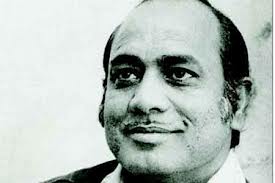 Ustad Mehdi Hassan is definitely one of the greatest singers of all times and of course, one of my personal favourites. His silken voice does the magic and directly touches your soul. Apart from the emotional content of Hassan’s voice, his throw of words is phenomenal. A ghazal being an elite literary form, the way you pronounce the words and the way you sing the sher is also very important to have a flawless rendition of the ghazal.
Ustad Mehdi Hassan is definitely one of the greatest singers of all times and of course, one of my personal favourites. His silken voice does the magic and directly touches your soul. Apart from the emotional content of Hassan’s voice, his throw of words is phenomenal. A ghazal being an elite literary form, the way you pronounce the words and the way you sing the sher is also very important to have a flawless rendition of the ghazal.
I believe that developing a taste for the literary as well as the musical form of ghazal is highly enriching. I hope that I have motivated you in some way to try it.
PS: The piece in the previous post demonstrated how expressive music can be with even meaningless lyrics whereas this is a composition whose soul lies as much in its profound lyrics as in its music. Such contrasts just make us realize the vastness of the world of music !
For the more interested listener…
Raag Yaman is one of the oldest and most popular Raagas in the Hindustani classical style. In Carnatic style it is called Raag Kalyani. The combination of the notes in this Raag is so brilliant that it can express almost any emotion (ras) very effectively. This ghazal is a very beautiful Yaman in itself !!
Apart from this, Iqbal Bano a famous Pakistani semi classical singer presents a quite different version of the ghazal. This is based in Raag Des and shows influences of another semi classical form of Thumri.
To commence this musical journey, I will consider this brilliant piece from the sound track of the movie Gladiator: ‘Now we are free’
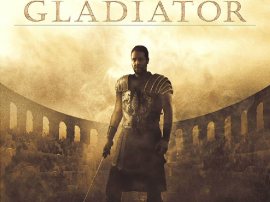 The movie is set in the Roman war era and has an aesthetic backdrop of afterlife to it. It’s about an immensely valiant warrior who is waiting to achieve his purpose in life, his vengeance, before transcending to heaven, to be one with his family. This piece tries to capture exactly this moment when his purpose in life is fulfilled and he is now free. It beautifully balances the gravity of the warrior’s last war with the spirit of heaven.
The movie is set in the Roman war era and has an aesthetic backdrop of afterlife to it. It’s about an immensely valiant warrior who is waiting to achieve his purpose in life, his vengeance, before transcending to heaven, to be one with his family. This piece tries to capture exactly this moment when his purpose in life is fulfilled and he is now free. It beautifully balances the gravity of the warrior’s last war with the spirit of heaven.
The piece begins with a marching rhythm and a mellow chord progression sets the mood. Lisa Gerrard’s haunting vocals kick in and a beautiful echo effect embellishes the vocals. Fast paced lyrics come in later, as if to signify the calling from heaven. Towards the end, the percussion stops and the soothing vocals bring in the effect of a final goodbye and calm that permeates after that.
Impact:
This track by the composer Hans Zimmer is definitely a pioneering work. Not only has this track attained the popularity levels of the music of Titanic or Star Wars, but it has also been critically acclaimed for being in perfect tune with the vision of the film. Hans Zimmer bagged the Oscar for Best Original Music Score for the film and several other awards as well. This piece showcases that being creative is not sufficient for a film composer, he also has to be meticulous and methodical in many ways. Hans Zimmer set a trend for all ancient war movies that followed.
Instrumental Arrangement:
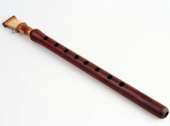 The piece of course uses traditional orchestral elements like chord progressions with pianos and cellos. Also, the rhythm is heavily influenced from classical Viennese waltz structure. Apart from this, Zimmer also uses some indigenous instruments like Duduk (a flute-like instrument from Armenia) to give harmony and some African percussion instruments.
The piece of course uses traditional orchestral elements like chord progressions with pianos and cellos. Also, the rhythm is heavily influenced from classical Viennese waltz structure. Apart from this, Zimmer also uses some indigenous instruments like Duduk (a flute-like instrument from Armenia) to give harmony and some African percussion instruments.
Vocals:
Typically, chants are the ancient prayers that used to be sung (are occasionally sung even today) in churches. The vocals are loosely influenced from German choral chants. This helps to bring about the effect of the Roman era. Heightened vocals have also been used occasionally to create harmony and a contrast effect. Lisa Gerrard fills the silhouette created by the instruments with wonderful precision of her vocals.
Lyrics:
The lyrics do not mean anything, whatsoever. Lisa Gerrard has sung the piece in a language she herself has created, a language in which she used to communicate with God since the time she was very young. Some people claim that few of the words sound like Hebrew and there are translated versions of the lyrics as well. (It’s indeed surprising how people can translate words from a language that does not exist !!) But the fact remains that the lyrics are just made-up. An advanced version of singing la-la-la or na-na-na, I would say..
 All in all, this piece as a whole aesthetically captures the world of Rome as well as the glimpses of afterlife that garnish the movie. It always gives me a feeling of great hope, combined with inner peace when I listen to it. Hope you all enjoy the piece as well 🙂
All in all, this piece as a whole aesthetically captures the world of Rome as well as the glimpses of afterlife that garnish the movie. It always gives me a feeling of great hope, combined with inner peace when I listen to it. Hope you all enjoy the piece as well 🙂
PS: I sincerely recommend you to watch the movie Gladiator if you haven’t already watched it. Of course the movie is brilliant, but if not for the movie then to better appreciate the music in context of the movie !!
For the more interested listener…
Viennese waltz is considered as the original form of waltz with a relatively slow pace. This is a piece of Viennese waltz that I found nice. (Somehow it reminds me of the bollywood song raja ko rani se pyaar ho gaya !!)
Initially, the chants were limited in pitch range and were monophonic. The melodies have striking similarities with the melodies of ancient shlokas of Rigvedas. It’s an amazing coincidence that the melody of prayers evolved independently for the Church and for the Hindu temples share such similarities !!
Music is what feelings sound like. It’s beyond imagination how there is a musical composition depicting each shade of every emotion. It won’t be an exaggeration to say that it’s the ultimate means of expression.
It often happens with us that we like some musical composition but we cannot pinpoint exactly what was it that touched our heart. Maybe it was the mellifluous voice of the singer, maybe it was the unique rhythm, maybe the guitar solo struck a chord with you or maybe the lyrics just narrate a story close to your heart. Each composition has its own musical and creative strengths. Knowing such a strength can be an emotional revelation!
Sometimes a detail makes us look at a piece of art in a whole new light. Its like having a closet in front of your eyes for years and then suddenly discovering a drawer in the closet you never noticed before..
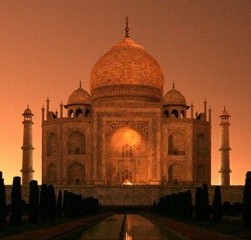 For example, we all find the Taj Mahal an exquisite piece of art. But when we get to know that depending on the time of the day, the Taj Mahal appears of a different color, it increases our awe for the wonder of the world.
For example, we all find the Taj Mahal an exquisite piece of art. But when we get to know that depending on the time of the day, the Taj Mahal appears of a different color, it increases our awe for the wonder of the world.
The same is the case with the masterpiece of Mona Lisa. The painting made use of a technique called ‘sfumato’, a technique which produces soft, imperceptible transitions between colors and tones. This also subtly hints the transition intended by the social renaissance then. What other hints the smiling lady is trying to give, is still a matter of great curiosity in the art community.
A brilliant piece of art always depicts more than you can see, stands for something much more than it seems to.
And knowing what makes something great makes you a connoisseur, transcends you from a mere admirer to a serious informant. It adds new dimensions to your perspective, gives you greater insight into life itself.
Through this blog I will try to explore the details, the intricacies of some beautiful compositions. Being a follower of the religion of music, I believe I will definitely have something interesting to share with you all.
To be able to appreciate art is one of the most treasured gifts of mankind. This is my small attempt to help you rediscover the gift.